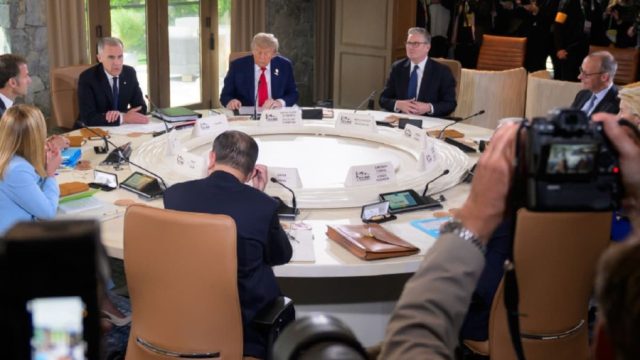NEW YORK, Tuesday, June 17, 2025 (WNP): In a dramatic turn of events, U.S. President Donald Trump abruptly announced his early departure from the G7 summit in Canada, citing the rapidly deteriorating situation in the Middle East following intensifying hostilities between Israel and Iran.
Trump’s decision came shortly after he posted a series of alarming messages on social media, including a stark warning urging residents of Tehran to “immediately evacuate,” and a renewed insistence that Iran “must never” possess nuclear weapons. “America First means many GREAT things, including the fact that IRAN CANNOT HAVE A NUCLEAR WEAPON,” he wrote on Truth Social.
White House Press Secretary Karoline Leavitt confirmed the president’s early departure in a statement on X, saying that while “much was accomplished” during Monday’s G7 meetings, Trump would return to Washington “because of what’s going on in the Middle East.” The president is expected to skip his scheduled meetings on Tuesday, including bilateral talks with Ukrainian President Volodymyr Zelensky and Mexican President Claudia Sheinbaum.
The White House’s announcement followed a series of grim social media posts from Trump, escalating concern over the conflict. His call for the evacuation of Tehran—a city of over 10 million people—coincided with Israeli orders for northern Tehran residents to seek shelter as its military campaign expanded.
According to a New York Times front-page report, Trump is weighing a pivotal decision: whether to support Israel in launching a direct strike on Iran’s highly fortified Fordo nuclear facility—an underground site only vulnerable to the U.S.’s most powerful bunker-buster bombs deployed by B-2 stealth bombers. If approved, the strike would draw the United States into the conflict, contradicting Trump’s previous campaign promises to avoid new wars in the Middle East.
Iranian officials have warned that any U.S. involvement in an Israeli-led attack would doom the already fragile prospects of reviving a nuclear agreement—one Trump has repeatedly claimed he still wishes to negotiate.
Meanwhile, Pentagon spokesperson Sean Parnell said Monday night that U.S. forces remain in a defensive posture in the region, emphasizing the protection of American personnel and interests. “We will protect American troops and our interests,” he said on X.
The current crisis began on Friday when Israeli missiles struck Iranian nuclear facilities, killing several high-ranking military officials. Since then, both nations have exchanged escalating strikes. While the U.S. initially described Israel’s attack as a unilateral move, media reports indicate that American forces supported Israel in intercepting retaliatory Iranian missiles.
Trump, who arrived in Kananaskis on Sunday for the G7, was seen posing for the traditional “family photo” with fellow leaders before cutting his visit short. Speaking briefly to reporters, Trump explained, “I have to be back as soon as I can,” and emphasized that his early departure was not due to any summit-related issue. “I wish I could stay for tomorrow, but they understand,” he added.
Earlier in the day, Trump had delivered mixed messages about Iran’s intentions. “Iran is not winning this war, and they should talk—immediately—before it’s too late,” he said. Later, he struck a more hopeful tone, suggesting that Tehran might be ready to negotiate. “I think Iran basically is at the negotiating table. They want to make a deal,” he said, hinting at possible diplomatic moves upon his return to Washington.
With the conflict threatening to spiral further, Trump’s next steps are being closely watched amid fears of a broader regional war and renewed questions about U.S. military involvement in the Middle East.




